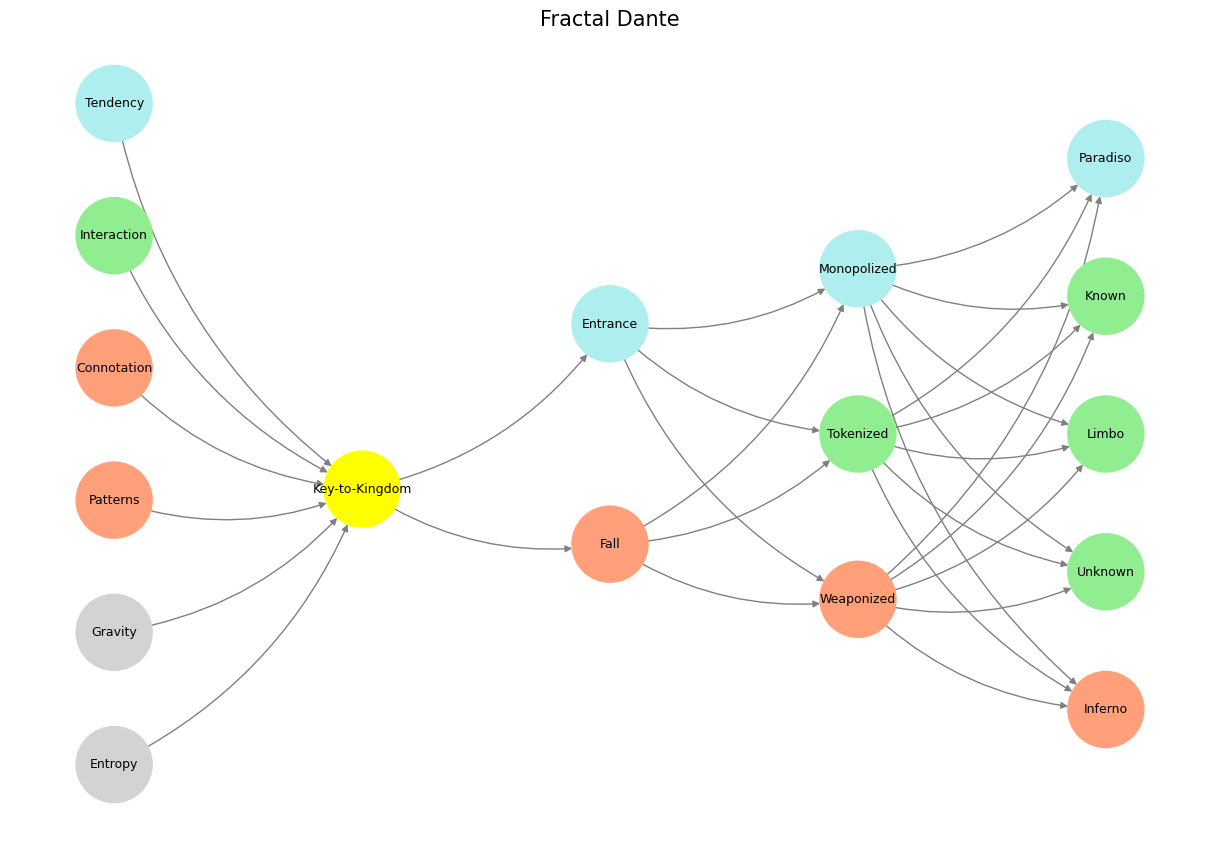Anchor ⚓️#
In the complex tapestry of human existence, the themes we explore can often be visualized through the metaphor of a fractal, a pattern that repeats at every scale. This essay delves into the parallels between Shakespeare’s “As You Like It,” the realm of cryptocurrency and artificial general intelligence (AGI), and the novelistic exploration of coffee culture, using the fractal structure of a neural network with its six input nodes and five layered themes.
World in Shakespeare’s play is not just the setting but an active participant in shaping narrative and character, much like the first layer of our fractal neural network. Jaques, with his melancholic yet insightful commentary on life, represents the second layer, Perception. His famous monologue about the seven ages of man reflects how we perceive our existence within the world. The contrast between Exits vs. Entrances speaks to Agency—the third layer—where choices, whether to enter or leave, define our actions and our identity. The Stage: Full of Sound & Fury mirrors the Generative layer, where actions, words, and performances create meaning, only for Jaques to conclude that it “signifies nothing,” which loops back to the Physical layer, suggesting a feedback loop where actions in the world echo back to influence perception and agency.

Fig. 4 Strategic Ambiguity. The Red Queen presents rather fascinating scenarios to us.#
In the realm of Crypto and AGI, the fractal layers take on a different hue. Gate-keepers act as the guardians of knowledge and access, akin to the world layer, determining who can enter this new digital landscape. Keys to the Kingdom—cryptographic keys—serve as the perception of power and control, defining how one can interact with this world. The notion of Worthy vs. Unworthy engages with agency, where one’s worthiness is constantly tested in the Laboratory or Jungle, Rat-race, echoing the generative layer where survival and innovation are paramount. The ultimate goal, the Entrenchment of Paradise with its Gifts & Trophies to Olympiads, mirrors the physical feedback, where success in this digital age leads back to shaping the world and its gatekeepers.
Turning to the Various Flavors of Coffee (novel), the fractal layers reveal a narrative of human endeavor and cultural confluence. The Errand boy, son-in-law from various literary works represents the world layer, where characters navigate their societal roles. Christianity, Civilization, Commerce, Coffee, Cafe-house are the lenses through which we perceive our culture and history, illustrating the perception layer. The Road of Skulls and the Law of the Jungle invoke a sense of the harsh agency required to navigate life’s challenges, resonating with the generative layer. Finally, the promise of Milk & Honey reflects the physical layer’s feedback into the world, where cultural and personal achievements feed back into the narrative, shaping future perceptions and actions.
Each of these thematic explorations, from Shakespeare’s theatrical world to the digital gates of crypto and AGI, to the cultural journey through coffee, can be seen as parts of a single, repeating pattern—a fractal. This pattern in neural networks, with its input nodes of Entropy, Gravity, Patterns, Connotation, Interaction, and Tendency, suggests that our understanding of the world, our interactions within it, and the narratives we create are not only interconnected but also cyclical, influencing each other in a continuous loop of cause and effect, perception, and transformation. This fractal view of life, literature, and technology invites us to see the unity in diversity, the repetition in change, and the profound interconnectedness of all things.
Show code cell source
import numpy as np
import matplotlib.pyplot as plt
import networkx as nx
# Define the neural network fractal
def define_layers():
return {
'World': ['Entropy', 'Gravity', 'Patterns', 'Connotation', 'Interaction', 'Tendency', ], ## Cosmos, Planet
'Perception': ['Key-to-Kingdom'], # Life
'Agency': ['Fall', 'Entrance'], # Ecosystem (Beyond Principal-Agent-Other)
'Generative': ['Weaponized', 'Tokenized', 'Monopolized'], # Generative
'Physical': ['Inferno', 'Unknown', 'Limbo', 'Known', 'Paradiso'] # Physical
}
# Assign colors to nodes
def assign_colors():
color_map = {
'yellow': ['Key-to-Kingdom'],
'paleturquoise': ['Tendency', 'Entrance', 'Monopolized', 'Paradiso'],
'lightgreen': ['Interaction', 'Tokenized', 'Known', 'Limbo', 'Unknown'],
'lightsalmon': [
'Patterns', 'Connotation', 'Fall', # Ecosystem = Red Queen = Prometheus = Sacrifice
'Weaponized', 'Inferno'
],
}
return {node: color for color, nodes in color_map.items() for node in nodes}
# Calculate positions for nodes
def calculate_positions(layer, x_offset):
y_positions = np.linspace(-len(layer) / 2, len(layer) / 2, len(layer))
return [(x_offset, y) for y in y_positions]
# Create and visualize the neural network graph
def visualize_nn():
layers = define_layers()
colors = assign_colors()
G = nx.DiGraph()
pos = {}
node_colors = []
# Add nodes and assign positions
for i, (layer_name, nodes) in enumerate(layers.items()):
positions = calculate_positions(nodes, x_offset=i * 2)
for node, position in zip(nodes, positions):
G.add_node(node, layer=layer_name)
pos[node] = position
node_colors.append(colors.get(node, 'lightgray')) # Default color fallback
# Add edges (automated for consecutive layers)
layer_names = list(layers.keys())
for i in range(len(layer_names) - 1):
source_layer, target_layer = layer_names[i], layer_names[i + 1]
for source in layers[source_layer]:
for target in layers[target_layer]:
G.add_edge(source, target)
# Draw the graph
plt.figure(figsize=(12, 8))
nx.draw(
G, pos, with_labels=True, node_color=node_colors, edge_color='gray',
node_size=3000, font_size=9, connectionstyle="arc3,rad=0.2"
)
plt.title("Fractal Dante", fontsize=15)
plt.show()
# Run the visualization
visualize_nn()


Fig. 5 How now, how now? What say the citizens? Now, by the holy mother of our Lord, The citizens are mum, say not a word.#

